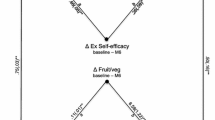Abstract
This study was designed to investigate self-objectification, its theoretical consequences, and its relationship to reasons for exercise within a fitness center environment. Sixty female aerobic instructors and 97 female aerobic participants, who ranged in age from 18 to 45 years, completed questionnaire measures of self-objectification, reasons for exercise, body dissatisfaction, and disordered eating. Increased self-objectification (and self-surveillance) was related to disordered eating symptomatology, body dissatisfaction, and appearance-related reasons for exercise. Aerobic instructors scored significantly lower on self-objectification, body dissatisfaction, and disordered eating than did aerobic participants, and they exercised more for enjoyment and less for appearance-related reasons. For aerobic participants, location of exercise (inside or outside the fitness center) moderated the relationship between frequency of exercise and self-objectification, such that exercising within fitness centers was associated with relatively higher self-objectification. Higher levels of self-objectification were also related to wearing tighter exercise clothing. These results support the general model of Objectification Theory, and provide practical implications for women who exercise within objectifying environments.
Similar content being viewed by others
References
Davis, C. (1990). Weight preoccupation and addictiveness: The role of exercise. Personality and Individual Differences, 11, 823–827.
Fredrickson, B. L., & Roberts, T. (1997). Objectification theory: Toward understanding women’s lived experiences and mental health risks. Psychology of Women Quarterly, 21, 173–206.
Fredrickson, B. L., Roberts, T., Noll, S. M., Quinn, D. M., & Twenge, J. M. (1998). That swimsuit becomes you: Sex differences in self-objectification, restrained eating, and math performance. Journal of Personality and Social Psychology, 75, 269–284.
Furnham, A., Badmin, N., & Sneade, I. (2002). Body image dissatisfaction: Gender differences in eating attitudes, self-esteem, and reasons for exercise. Journal of Psychology, 136, 581–596.
Garner, D. M., Olmstead, M. P., & Polivy, J. (1983). Development and validation of a multidimensional Eating Disorder Inventory for anorexia nervosa and bulimia. International Journal of Eating Disorders, 2, 15–34.
Harrison, K., & Fredrickson, B. L. (2003). Women’s sports media, self-objectification, and mental health in Black and White adolescent females. Journal of Communication, 53, 216–232.
Iannos, M., & Tiggemann, M. (1997). Personality of the excessive exerciser. Personality and Individual Differences, 22, 775–778.
Jourard, S. M., & Secord, P. F. (1955). Body-cathexis and the ideal female figure. Journal of Abnormal and Social Psychology, 50, 243–246.
Martin Ginis, K. A., Jung, M. E., & Gauvin, L. (2003). To see or not to see: Effects of exercising in mirrored environments on sedentary women’s feeling states and self-efficacy. Health Psychology, 22, 354–361.
Martin, K. A., & Hausenblas, H. A. (1998). Psychological commitment to exercise and eating disorder symptomatology among female aerobic instructors. Sport Psychologist, 12, 180–190.
McCaulay, M., Mintz, L., & Glenn, A. A. (1988). Body image, self-esteem, and depression-proneness: Closing the gender gap. Sex Roles, 18, 381–391.
McDonald, K., & Thompson, J. K. (1992). Eating disturbance, body image dissatisfaction, and reasons for exercising: Gender differences and correlational findings. International Journal of Eating Disorders, 11, 289–292.
McKinley, N. M. (1998). Gender differences in undergraduates’ body esteem: The mediating effect of objectified body consciousness and actual/ideal weight discrepancy. Sex Roles, 39, 113–123.
McKinley, N. M., & Hyde, J. S. (1996). The Objectified Body Consciousness Scale: Development and validation. Psychology of Women Quarterly, 20, 181–215.
Mcnelis-Kline, C. M. (2000). Body image, social physique anxiety and eating disorders in aerobic instructors. Dissertation Abstracts International: Section B: the Sciences and Engineering, 61(2-B), 1090.
Noll, S. M., & Fredrickson, B. L. (1998). A mediational model linking self-objectification, body shame, and disordered eating. Psychology of Women Quarterly, 22, 623–636.
Olson, M. S., Williford, H. N., Richards, L. A., Brown, J. A., & Pugh, S. (1996). Self-reports on the Eating Disorder Inventory by female aerobic instructors. Perceptual and Motor Skills, 82, 1051–1058.
Penas-Lledo, E., Sancho, L., & Waller, G. (2002). Eating attitudes and the use of alcohol, tobacco, and exercise among male and female adolescents. Eating Behaviors, 3, 101–111.
Schoemaker, C., van Strien, T., & van der Staak, C. (1994). Validation of the Eating Disorders Inventory in a nonclinical population using transformed and untransformed responses. International Journal of Eating Disorders, 15, 387–393.
Silberstein, L. R., Striegel-Moore, R. H., Timko, C., & Rodin, J. (1988). Behavioural and psychological implications of body dissatisfaction: Do men and women differ? Sex Roles, 19, 219–232.
Smolak, L., Murnen, S. K., & Ruble, A. E. (2000). Female athletes and eating problems: A meta-analysis. International Journal of Eating Disorders, 27, 371–380.
Strelan, P., Mehaffey, S. J., & Tiggemann, M. (2003). Self-Objectification and esteem in young women: The mediating role of reasons for exercise. Sex Roles, 48, 89–95.
Tiggemann, M. (2004). Body image across the adult life span: Stability and change. Body Image, 1, 29–41.
Tiggemann, M., & Kuring, J. K. (2004). The role of body objectification in disordered eating and depressed mood. British Journal of Clinical Psychology, 43, 299–311.
Tiggemann, M., & Lynch, J. E. (2001). Body image across the life span in adult women: The role of self-objectification. Developmental Psychology, 37, 243–253.
Tiggemann, M., & Slater, A. (2001). A test of objectification theory in former dancers and non-dancers. Psychology of Women Quarterly, 25, 57–64.
Tiggemann, M., & Williamson, S. (2000). The effect of exercise on body satisfaction and self-esteem as a function of gender and age. Sex Roles, 43, 119–127.
Author information
Authors and Affiliations
Corresponding author
Rights and permissions
About this article
Cite this article
Prichard, I., Tiggemann, M. Objectification in Fitness Centers: Self-Objectification, Body Dissatisfaction, and Disordered Eating in Aerobic Instructors and Aerobic Participants. Sex Roles 53, 19–28 (2005). https://doi.org/10.1007/s11199-005-4270-0
Issue Date:
DOI: https://doi.org/10.1007/s11199-005-4270-0



